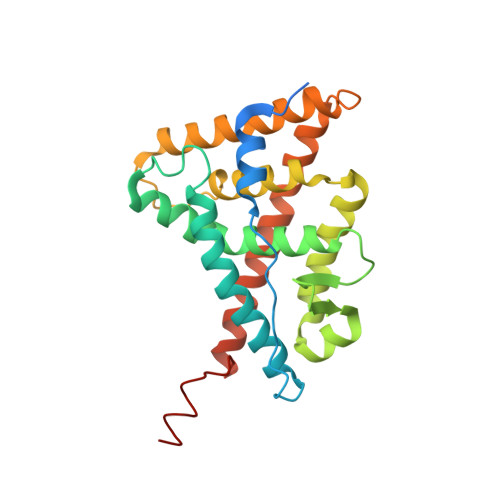Structural Basis for the Deactivation of the Estrogen-related Receptor {gamma} by Diethylstilbestrol or 4-Hydroxytamoxifen and Determinants of Selectivity.
Greschik, H., Flaig, R., Renaud, J.P., Moras, D.(2004) J Biological Chem 279: 33639-33646
- PubMed: 15161930
- DOI: https://doi.org/10.1074/jbc.M402195200
- Primary Citation of Related Structures:
1S9P, 1S9Q, 1TFC, 1VJB - PubMed Abstract:
The estrogen-related receptor (ERR) gamma behaves as a constitutive activator of transcription. Although no natural ligand is known, ERRgamma is deactivated by the estrogen receptor (ER) agonist diethylstilbestrol and the selective ER modulator 4-hydroxytamoxifen but does not significantly respond to estradiol or raloxifene. Here we report the crystal structures of the ERRgamma ligand binding domain (LBD) complexed with diethylstilbestrol or 4-hydroxytamoxifen. Antagonist binding to ERRgamma results in a rotation of the side chain of Phe-435 that partially fills the cavity of the apoLBD. The new rotamer of Phe-435 displaces the "activation helix" (helix 12) from the agonist position observed in the absence of ligand. In contrast to the complexes of the ERalpha LBD with 4-hydroxytamoxifen or raloxifene, helix 12 of antagonist-bound ERRgamma does not occupy the coactivator groove but appears to be completely dissociated from the LBD body. Comparison of the ligand-bound LBDs of ERRgamma and ERalpha reveals small but significant differences in the architecture of the ligand binding pockets that result in a slightly shifted binding position of diethylstilbestrol and a small rotation of 4-hydroxytamoxifen in the cavity of ERRgamma relative to ERalpha. Our results provide detailed molecular insight into the conformational changes occurring upon binding of synthetic antagonists to the constitutive orphan receptor ERRgamma and reveal structural differences with ERs that explain why ERRgamma does not bind estradiol or raloxifene and will help to design new selective antagonists.
- Département de Biologie et Génomique Structurales, Institut de Génétique et de Biologie Moléculaire et Cellulaire, 1 rue Laurent Fries, B. P. 10142, 67404 Illkirch, France.
Organizational Affiliation:


















